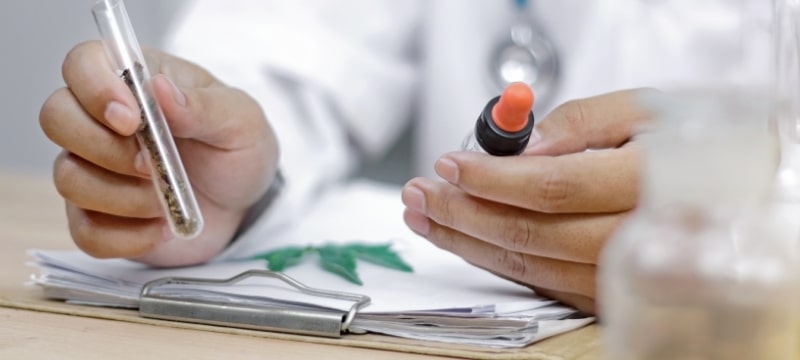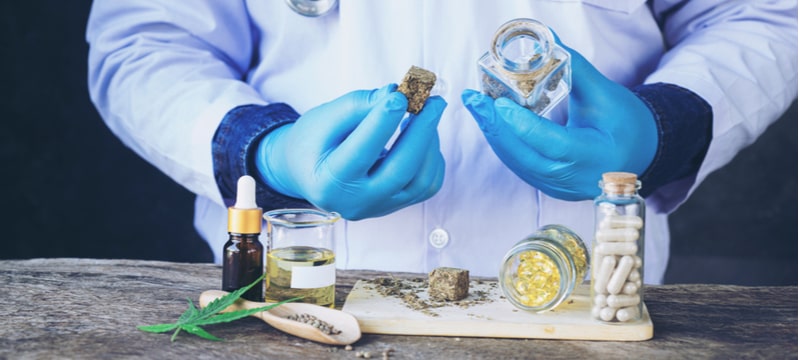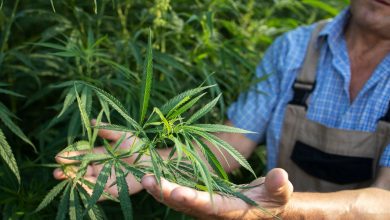
CBD Products have become mainstream over the last few years and with legalisation becoming more widespread in the UK and across Europe it’s important that consumers understand that what they’re buying is safe
Table of Contents
The importance of a Certificate of Analysis
The most effective way to check this is through a Certificate of Analysis, more commonly known as a COA.
Currently, CBD is, for the most part, a highly unregulated market and while legislation and the EU Novel Foods Act, which requires applications to be validated by March 2021, are actively working to improve this, it has led to issues across the UK CBD industry.
What exactly is a Certificate of Analysis?
A COA is a document containing a CBD Third-Party lab report, which in layman terms means, it is a document providing an unbiased verification that what a company says is in your product is actually in your product.
A Certificate of Analysis or third-party lab report is carried out by labs that have no monetary interest in the CBD company they are testing for, meaning they will provide an honest breakdown of what is in your CBD product.
There are many aspects that can affect the quality of a CBD product, for example, the extraction process used can affect the stability or create chemical residues. Hemp is also a bioaccumulator meaning it could have absorbed harmful chemicals or pesticides, which will show up on the CoA if present.
Why should a CBD company have a third-party lab report?
Transparency is important for your customers in a market that is relatively new and unregulated. If you want to survive, it’s best to do so from the start. Unfortunately due to the lack of regulation in place across the UK CBD Industry, some CBD producers have deceived customers on the content of CBD or THC in their products.
Providing a CoA is paramount in allowing customers to feel safe that the CBD products they purchase are free from harmful toxins, have the correct amount of CBD in it and is below the legal level of THC in the UK. Never buy Raw ingredients or CBD products unless the supplier can provide a COA.
In the past, the FDA has had to warn CBD companies who had been advertising CBD products which contained little to no amount of CBD in them. This caused huge backlash to the UK CBD industry and prompted consumers and sellers alike to demand better regulation and transparency amongst CBD companies.
How to read a certificate of analysis?
How to read a CBD third-party lab report can be confusing the first time you look at it, however, it is simple if you know what you are looking for. Once you know the important compounds to identify the rest is simple; CBD, CBDa, CBG, THC.
It is important to note that CoA layouts can vary depending on the lab used, some CoA’s may also only focus on the cannabinoid profile depending on the type of test carried out.
COA header and company information
The header you will see on a UK Certificate of Analysis is everything above the actual results. This part of the test demonstrates the legality of the report. Important aspects to note here would be the date, is it recent to show the company carried out regular tests, how the sample was prepared and that the name of the sample actually corresponds with the product you're looking at.
This section will also show who the COA is being issued to, which should be your brand name but in some cases will actually list the company it was white labelled from.
Cannabinoid profile
Depending on the type of third-party lab report carried out, this may be the only information listed on the lab report. If not it will continue on to the body of the report, listed below.
This is the most vital part of a COA as it will tell you if the correct levels of CBD and THC are in your product, as well as other cannabinoids present. Below we break down what you might see listed here:
What is CBD?
Cannabidiol is a chemical compound from the Cannabis sativa plant and does not contain psychoactive properties. It is one of the major components found in the cannabis plant and has been hailed for its reported relaxing and calming effects.
CBD is the main compound you want to see on your report. For your certificate of analysis, this is one of the most important parts of the test, to determine the amount of CBD is what it should be.
What is CBDa?
CBDa or cannabidiolic acid is a compound present in hemp and cannabis plants. When exposed to heat it converts to CBD. CBDa is a raw form of CBD and requires heat to convert it to CBD.
CBDa does not interact with our endocannabinoid system, instead, it works with non-endocannabinoid enzymes within our body.
What is CBC?
Cannabichromene or CBC is a lesser now cannabinoid present in the hemp or cannabis plant. This cannabinoid has shown promising results in studies so far, in 2013 a study conducted with mice showed CBC could positively stimulate new cell growth, in a process known as neurogenesis.
CBC has also shown potential in anti-inflammatory properties, but it does not appear to use the endocannabinoid system to do so, meaning CBD becomes more effective when paired with other cannabinoids like CBD or THC.
What is CBCa?
Cannabichromenic acid (CBCA) is a precursor of CBC biosynthesis, a non-psychoactive cannabinoid of Cannabis that reportedly exerts anti-inflammatory, antimicrobial and analgesic activity.
What is CBG?
CBG or Cannabigerol is a lesser cannabinoid, due to the low levels that are present in the cannabis plant. CBG has shown exceptionally promising results in studies so far, as this compound appears to react with very specific physiological systems.
In January 2015, researchers found that CBG had a neuroprotective effect in mice with Huntington's disease, a disease characterised by degeneration of nerve cells in the brain. CBG slowed the progression of colon cancer in mice.
Due to CBG’s non-psychoactive properties and the results it has so far yielded, scientists have been particularly excited in learning more about the applications CBG could potentially be used for in the future.
What is CBGa?
Cannabigerolic acid or CBGa is known as the mother of cannabinoids. It is the precursor for three of the main cannabinoid families, THCa, CBDa, and CBCa.
Without this incredible compound, the others would not exist. Certain enzymes within the cannabis plant will break down the CBGa and direct it towards one of the 3 groups above. This can happen through exposure to heat or ultraviolet light.
It can also become CBG, but this is less often the case, for farmers who want to yield higher levels of CBG, cross-breeding plants is key to gaining the desired amount of the compound.
What is CBN?
Cannabinol or CBN is created when THC ages, usually derived from older marijuana and cannabis plants. Unlike THC, CBN is non-psychoactive and has been undergoing testing in the pharmaceutical industry due it’s potential medicinal properties.
It is widely known to cause a sedative effect on the user, however, there have not been enough human studies at this stage to determine if this is the case. One small human study carried out in 1970 reported that none of the users felt a sedative effect. While there could be numerous reasons not yet discovered as to why people still claim it does cause sedation, this could be down to a mixture of THC.
CBN has also shown great promise in early studies for antiemetic effect, anticonvulsant effect, pain reduction and decreased intraocular pressure.
What is THC?
Tetrahydrocannabinol more commonly known as THC is the compound within a cannabis plant that gets you ‘high’. While THC has shown a number of promising applications, it has come under fire for its psychoactive properties.
Most of the regulations surrounding CBD are in place due to this compound. When reading a Certificate of Analysis it is important to note that the legal compound you need to check for, is often listed on the CoA as delta-9-tetrahydrocannabinol, and must be below 1mg.
What is THCa?
Tetrahydrocannabinol acid or THCa is the chemical compound found in cannabis or hemp plants. THCa is not psychoactive as it is not active THC yet.
THCa becomes THC during the decarboxylation process, which can happen gradually over time, when heat is added or naturally during heating cannabis while smoking it. Levels of THC present in a plant are usually minimal, with THCa more commonly found naturally in the plant.
Now that you know what types of cannabinoids you would typically see on a Certificate of Analysis, let’s have a look at what else might be on the main body of the report.
Body of a Certificate of Analysis
In some of the more robust CoA’s you will have a lot more data to digest than just your cannabinoid profile, this part of the report will show you the products Terpene Profile, Heavy Metals, Pesticides and Mycotoxins, We’ll look at these closer below.
Terpenes
Terpenes are known to contribute to the taste and aroma of plants. There are currently over 100 terpenes identified in the cannabis plant. While there is no definitive studies yet, it is widely believed that terpenes can also change the effects a strain will have on the user.
Terpenes are secreted in the same glands as THC and CBD and are a class of natural hydrocarbons found in plants and animals. Terpenes are found in medical cannabis leafs naturally and in CBD products often infused with terpenes including while label products like CBD champagne.
Some of the more common terpenes would include camphene, Caryophyllene, Limonene, Linalool, Myrcene, Pinene and Terpinene. These Terpenes are what causes distinctive flavours like citrus, berry, mint, and pine in cannabis plant strains.
Heavy Metals
Mercury, lead, cadmium, and arsenic are the main heavy metals a lab will test for detection.
The report will look at the Use Limit, which is the amount allowed to be present in a sample and compare it with the amount detected or detected concentration, Conc. If nothing is detected the relevant field will read ND for not detected.
Cannabis and Hemp have been hailed as a soil cleaning crop and can be highly effective at absorbing heavy metals. Often when grown by a licensed grower it would be rare to see Heavy Metals present in the crop, but it can happen.
If you are still not sure what you're looking for here the Certificate Of Analysis will also determine whether the sample has a Pass or Fail rate for this section.
Pesticides
Much like the Heavy Metals part of a report, you will see the Use Limit, to determine acceptable levels present, and your Conc. or Result for your sample. Cannabis Plants contain natural defences which prevent pesticides, again it is rare to see them present in a sample. However, in some cases, a farmer may be using pesticides on other crops which can be absorbed by the cannabis crop.
Again like the Heavy Metals, the report will determine if the sample has been given an overall pass or Fail.
Mycotoxins
This part of the report will follow a similar line up to the previous sections, using a Limit and Result as well as showing you whether the sample gets a Pass or Fail. But what are Mycotoxins?
Mycotoxins are toxic compounds that are naturally produced by certain types of moulds (fungi). The mould growth can happen at any stage of the process, before or after harvest, and often as mycotoxins are chemically stable they will survive food processing. They will often grow on foodstuffs under warm, damp or humid conditions.
Several hundred different mycotoxins have been identified, but the most commonly observed mycotoxins that present a concern to human health and livestock include aflatoxins, ochratoxin A, patulin, fumonisins, zearalenone and nivalenol/deoxynivalenol. (www.who.in)
How to choose a third-party lab in the UK for COA’s?
If providing a CoA is the most important aspect of selling CBD Products, the next most important thing is choosing the right lab to carry out the test. Firstly you should check that your lab is competent, you can do this by checking they compile with EN ISO / IEC 17025. This is the standard in most testing and calibration laboratories to be accredited as competent labs.
Secondly, you must choose the quality of the lab you want to use, the most important aspect being whether you choose an accredited lab or not. There are three brackets a chosen lab can fall into.
- Accredited Lab with a THC certified Test. This would be the most accurate, fully compliant test and carried out to the highest standard.
- Accredited Lab with a non-certified THC test. This test would be modest in accuracy and the highest quality available.
- Non accredited lab. This would be a poor quality test that is questionably compliant.
Do you need a Certificate of Analysis to sell CBD products in the UK?
Having third-party lab tests carried out on your CBD products is a requirement in the UK. You must be able to prove that your products have below the legal THC level to be safely sold on the market. However, having to use an accredited lab is not a requirement and therefore tests can vary in performance.
It is also not a requirement to provide these tests to consumers, however, not doing so can damage your company’s reputation, making a company appear untrustworthy, with transparency becoming more prominent in the industry. QR codes or Lab Report sections on the CBD Packaging or e-commerce has become a regular feature with top-performing brands.
In conclusion, if you are interested in selling or are already selling CBD on the UK market or anywhere else, you need to provide your customers with a competent UK Certificate of Analysis. Always check that the lab you choose to work with is certified and work with eBay practice in mind. Choose a reputable UK wholesale CBD company to work closely with.
If you are a consumer interested in purchasing CBD products, never buy from a brand that does not provide clearly accessible CoA’s, and always check them first to make sure that the quality, purity and effectiveness of the product is accurate to what the brand claims.





